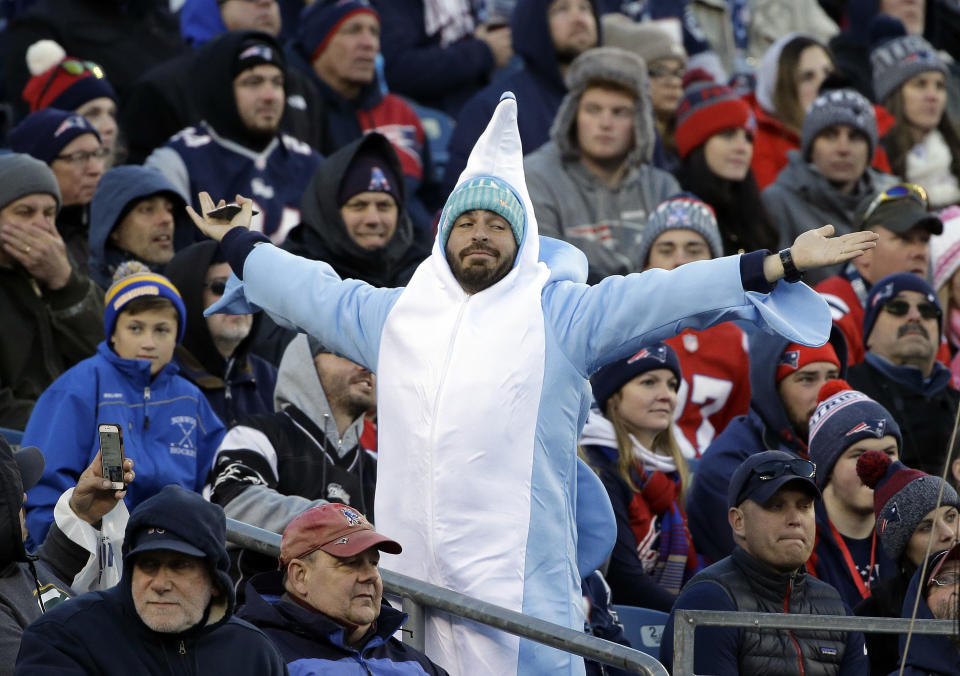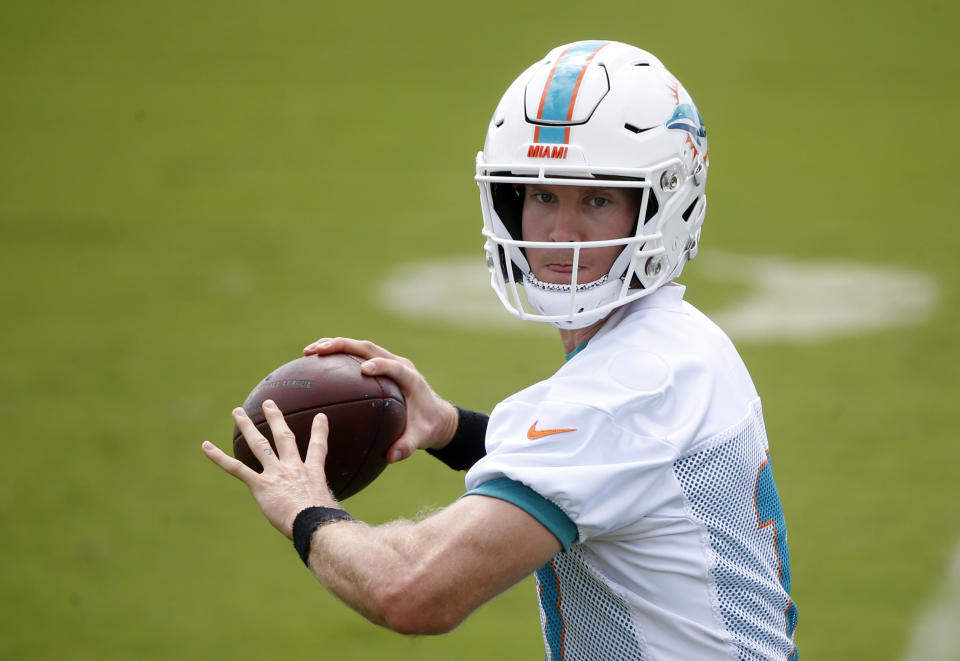Juggernaut Index, No. 31: Everything new in Miami is old

Adam Gase’s first season as Miami Dolphins head coach, back in 2016, went as well as anyone could have reasonably hoped. The team won 10 games, earning its first playoff berth since 2008. Four Dolphins made the Pro Bowl that year: Jay Ajayi, Jarvis Landry, Ndamukong Suh and Cameron Wake. Times were good.
Today, entering the third season of the Gase era, things are a bit different. The team is coming off a 6-10 season. Ajayi and Landry were dealt away and Suh was released.
[Yahoo Fantasy Football leagues are open: Sign up now for free!]
Last year’s offense was mostly miserable, as Jay Cutler replaced an injured Ryan Tannehill at quarterback. Miami ranked No. 28 in the league in scoring (17.6 PPG), No. 28 in yards per pass attempt (6.3), No. 29 in rushing (86.8 YPG) and dead-least in third-down conversion percentage (31.7). The Dolphins’ average yards per play fell from 5.8 in 2016 to 4.9 last season.
So it would be fair to say that 2018 is a huge year for Gase — and for Tannehill, and, generally, for this franchise. After being linked to pretty much every buzzy quarterback in the 2018 draft class, Miami selected none of them. Tannehill, coming off ACL surgery, will be backed up by Brock Osweiler. What could go wrong?
Ryan Tannehill is (finally) ambulatory, back in the game for Miami
We can forgive Cutler’s underwhelming performance last season, because he didn’t sign with Miami until August, having previously agreed to broadcast games for Fox. He was a placeholder QB for a team that still imagined it had the pieces necessary to remain competitive without Tannehill. Cutler was of course familiar with Gase’s offense, as the coach had been Chicago’s OC in 2015. The renewal of their partnership produced one of the season’s most ridiculous moments but very few explosive plays. Only two of Cutler’s 429 pass attempts resulted in gains of 40-plus yards.

And now Tannehill is back at the controls. Two seasons ago, he produced career highs in completion percentage (67.1), touchdown rate (4.9), yards per attempt (7.7) and passer-rating (93.5), so there’s little question that his work with Gase was promising. But his 2016 season ended in the second-half of a three-touchdown performance against Arizona in Week 14, when he suffered a multi-ligament knee injury. And then the rehab/re-injury/surgery fiasco happened, which gave us the Cutler experience.
Tannehill will enter his age-30 season having not taken a meaningful snap for 21 months. He’s delivered only one top-12 positional finish in his career (2014), so there’s no reason fantasy owners should expect anything more than, say, a 3900-24-12 line in a healthy season. To date, he’s proven to be competent if not inventive or spectacular; he’s been a capable runner, though he has just six rushing scores over five seasons. Post-injury, he’s not a QB to specifically target in any format. Superflex owners can certainly do much worse than Tannehill. He’d be easier to sell if any of his receivers were at all exciting.
Jarvis Landry is gone, leaving 160 targets up for grabs
Landry led the NFL in receptions last season (112), yet he somehow finished with just 987 yards. Only four players in league history have caught 100 or more balls yet gained less than 1000 yards; three of those players are running backs (Forte, Centers, Tomlinson), and the other dude is Landry. Let’s not pretend the Dolphins had to replace some dynamic, thrill-a-minute freak of a receiver when Landry was dealt to Cleveland. Still, he did finish with nine TD receptions last season, and he was peppered with targets throughout his career in Miami.
Much of Landry’s old workload should shift to new acquisitions Danny Amendola and Albert Wilson. Reporters close to the Dolphins seem to feel Amendola is going to be a volume receiver…
Random thought 3: Tannehill to Amendola is gonna be a thing in 2018, assuming they stay healthy.
— Armando Salguero (@ArmandoSalguero) May 23, 2018
…which makes good sense in theory. He’s a proven commodity who’s made big plays in the biggest moments. But he’s also 32 years old and doesn’t exactly have the cleanest medical chart. It seems ridiculous to project him to play 14-16 games if he’s about to see a significant percentage of Landry’s old workload. But hey, Amendola is probably going to produce a few 7-catch, 65-yard games, keeping the PPR crowd content. He’ll be a dirt-cheap late option at the draft table. Wilson was an interesting pickup as well, and he’s coming off a semi-breakout season in Kansas City (42-554-3). He’s been a high-buzz player throughout the offseason. I’d probably take the over on 50 catches for Wilson in 2018, and his ceiling is much higher. He signed for three years and $24 million, so the team clearly has plans for him.
Miami’s presumptive starting outside receivers are vets DeVante Parker — a player who burned many of us last season — and vertical threat Kenny Stills. The Dolphins seem to be making a deliberate effort to limit the Parker hype this summer, following the excessive fawning of 2017. He produced a quality season with Tannehill two years ago (56-744-4) and could easily make a small leap. Stills actually led this team in air yards per target (6.6), yards per catch (14.6) and gains of 20-plus yards (14) last year; he’s a better deal at his current price (ADP 162.3) than Parker (100.3).
You won’t find Julius Thomas in the team picture for Miami this year, which clears a path for Penn State rookie Mike Gesicki to make an immediate splash. It’s rare, of course, for a first-year tight end to achieve fantasy relevance, but Gesicki finds himself at the top of the depth chart. He was a productive receiver at the collegiate level (99 catches last two seasons) and he absolutely crushed the pre-draft combine (4.54 speed, 41.5-inch vertical). His athleticism definitely shows on film, too. You want him in dynasty drafts, and it’s not completely insane to snag him in deeper redraft leagues.
Kenyan Drake was a revelation, so of course this team added Frank Gore
The Dolphins’ ground game wasn’t anything special last season, gaining just 3.9 yards per attempt. But Kenyan Drake was a notable exception. He reached 90 scrimmage yards in four of his last five games, averaged 4.8 YPC on 133 total attempts and hauled in 32 passes on 50 targets. On a per-touch basis, his output last year basically matched Ajayi’s performance in 2016. Drake was clearly not the problem.

So, naturally, the team added Frank Gore, then drafted Arizona State’s Kalen Ballage. Position coach Eric Studesville recently declined to name any back as the clear starter. Let me tell you, these are nervous times for those of us who invested in Drake in dynasty. It seems almost unfathomable that Drake won’t dominate the backfield touches for this team, but Gore has topped 200 touches in every season since like 1956. That’s sixty-one consecutive years, you guys. (Gore and Hugh McElhenny were an unforgettable tandem for the Niners back in the day.)
If Gore hadn’t arrived on the scene to poach carries, Drake would have cracked the top-15 at his position for me. As things stand today, Drake is my RB20, which is pretty much in line with his ADP (35.4, RB19). I haven’t yet drafted him in best-ball leagues, though. This backfield has the makings of a messy committee. Ballage was never a full-workload runner at ASU, but he’s a big back (6-foot-3, 229) who has a 14-TD, 44-catch season on his resume. He enters camp well behind Drake and Gore, but it wouldn’t be a shock if he carved out a role.
For fantasy purposes, here’s the bottom line: Miami has only one player who consistently gets drafted among the overall top-100, and we can’t fully trust that guy. It’s not a recipe for a high ranking in this meaningless index. If you don’t have many (or any) shares of the Dolphins offense by the end of draft season, you probably won’t be filled with regret.
2017 Offensive Stats & Ranks
Points per game – 17.6 (28th in NFL)
Pass YPG – 220.9 (18)
Rush YPG – 86.8 (29)
Yards per play – 4.9 (22)
Plays per game – 62.2 (22)
Previous Juggernaut Index entries: 32) Buffalo
Follow the Yahoo fantasy football crew on Twitter: Andy Behrens, Dalton Del Don, Brad Evans, Liz Loza, Scott Pianowski and Tank Williams



